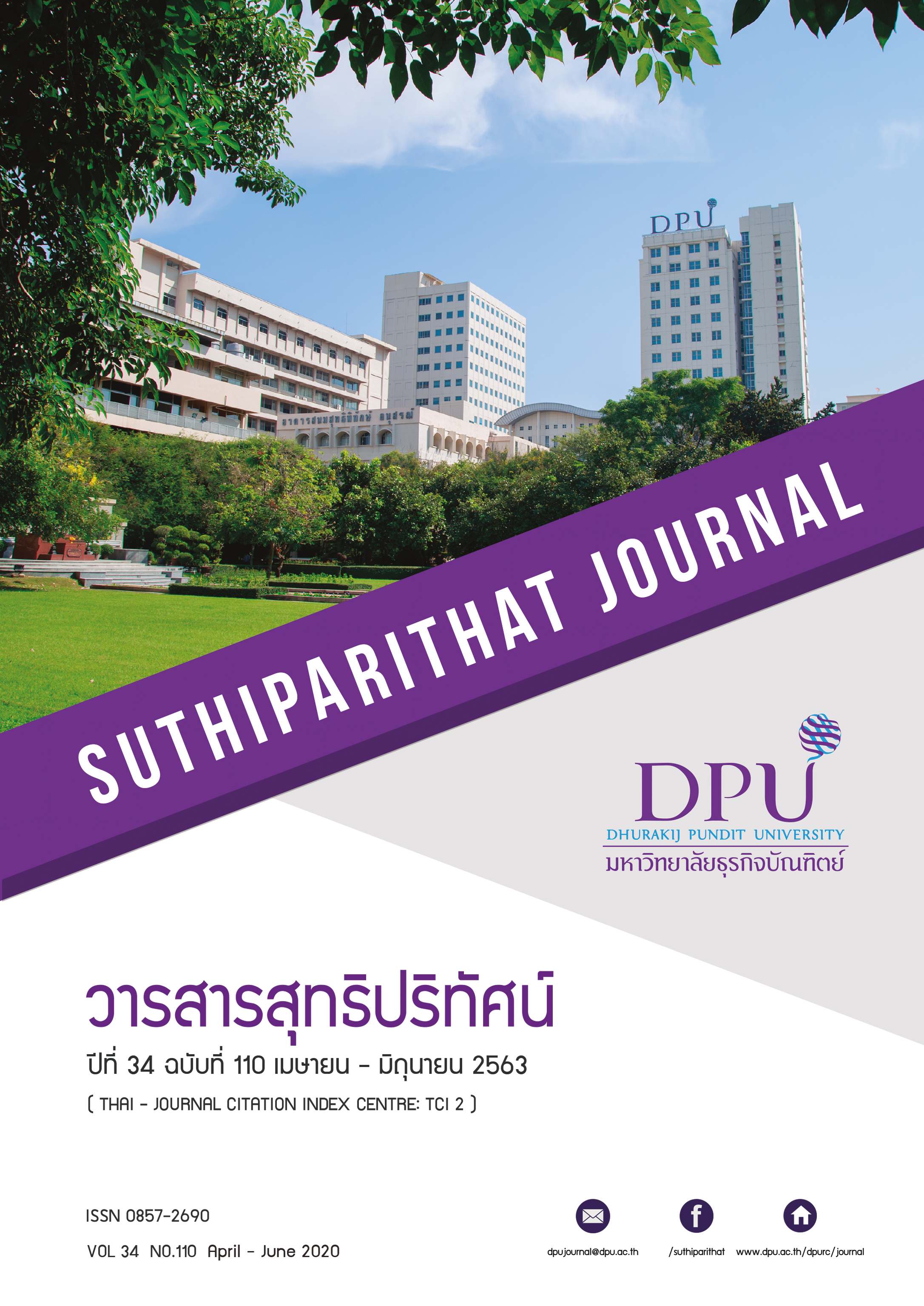อิทธิพลของบุคลิกภาพห้าองค์ประกอบ ความฉลาดทางอารมณ์ และบรรยากาศองค์การที่มีต่อพฤติกรรมต่อต้านการปฏิบัติงานของพนักงานขับรถโดยสารบริษัทขนส่งแห่งหนึ่ง
คำสำคัญ:
พฤติกรรมต่อต้านการปฏิบัติงาน, บุคลิกภาพห้าองค์ประกอบ, ความฉลาดทางอารมณ์, บรรยากาศองค์การบทคัดย่อ
การวิจัยครั้งนี้มีวัตถุประสงค์เพื่อศึกษาระดับบุคลิกภาพห้าองค์ประกอบ ความฉลาดทางอารมณ์ บรรยากาศองค์การ และระดับพฤติกรรมต่อต้านการปฏิบัติงานของพนักงานขับรถโดยสารบริษัทขนส่งแห่งหนึ่ง และศึกษาอิทธิพลของบุคลิกภาพห้าองค์ประกอบ ความฉลาดทางอารมณ์ และบรรยากาศองค์การที่มีต่อพฤติกรรมต่อต้านการปฏิบัติงานของพนักงานขับรถโดยสารบริษัทขนส่งแห่งหนึ่ง กลุ่มตัวอย่างที่ใช้ในการวิจัย คือ พนักงานขับรถโดยสารบริษัทขนส่งแห่งหนึ่ง จำนวน 291 คน เก็บข้อมูลโดยการใช้แบบสอบถาม สถิติที่ใช้วิเคราะห์ข้อมูล ได้แก่ ค่าร้อยละ ค่าเฉลี่ย ส่วนเบี่ยงเบนมาตรฐาน และการวิเคราะห์การถดถอยพหุคูณแบบขั้นตอน ผลการวิจัยพบว่า 1) พนักงานขับรถโดยสารบริษัทขนส่งแห่งหนึ่งมีบุคลิกภาพแบบหวั่นไหวอยู่ในระดับต่ำ บุคลิกภาพแบบแสดงออก แบบเปิดรับประสบการณ์ แบบอ่อนน้อม และแบบมีสติอยู่ในระดับปานกลาง 2) ความฉลาดทางอารมณ์โดยรวมอยู่ในระดับปานกลาง เมื่อพิจารณารายด้าน พบว่า ด้านการตระหนักรู้ตนเอง การควบคุมตนเอง การเอาใจเขามาใส่ใจเรา และทักษะทางสังคมอยู่ในระดับปานกลาง ในขณะที่การสร้างแรงจูงใจอยู่ในระดับสูง 3) บรรยากาศองค์การโดยรวมและรายด้านอยู่ในระดับสูง 4) พฤติกรรมต่อต้านการปฏิบัติงานโดยรวมและรายด้านอยู่ในระดับต่ำมาก 5) บุคลิกภาพแบบหวั่นไหว บุคลิกภาพแบบมีสติ และบรรยากาศองค์การด้านมาตรฐานสามารถร่วมกันพยากรณ์พฤติกรรมต่อต้านการปฏิบัติงานของพนักงานขับรถโดยสารบริษัทขนส่งแห่งหนึ่งได้ร้อยละ 17.4 อย่างมีนัยสำคัญทางสถิติที่ระดับ .05
เอกสารอ้างอิง
กรมสุขภาพจิต. (2550). อีคิว: ความฉลาดทางอารมณ์ (ฉบับปรับปรุง). นนทบุรี: กรมสุขภาพจิต.
ชูชัย สมิทธิไกร. (2551). ลักษณะบุคลิกภาพที่พยากรณ์พฤติกรรมต่อต้านการปฏิบัติงาน. วารสารสงขลานครินทร์ ฉบับสังคมศาสตร์และมนุษยศาสตร์, 14(4), 513 - 530.
ชูชัย สมิทธิไกร. (2557). จิตวิทยาอุตสาหกรรมและองค์การ (พิมพ์ครั้งที่ 2). กรุงเทพฯ: จุฬาลงกรณ์มหาวิทยาลัย.
เทอดศักดิ์ เดชคง. (2545). ความฉลาดทางอารมณ์ (พิมพ์ครั้งที่ 13). กรุงเทพฯ: มติชน.
ผู้จัดการออนไลน์. (2549). สูญเงินจากลักลอบขายน้ำมันปีละกว่า 50 ล้านบาท. สืบค้น 24 เมษายน 2561, จาก www.mgronline.com/business/detail/9490000108344
รัตติกรณ์ จงวิศาล. (2554). มนุษยสัมพันธ์: พฤติกรรมมนุษย์ในองค์การ (พิมพ์ครั้งที่ 3). กรุงเทพฯ: สำนักพิมพ์มหาวิทยาลัยเกษตรศาสตร์.
วรรณี แกมเกตุ. (2551). วิธีการวิจัยทางพฤติกรรมศาสตร์ (พิมพ์ครั้งที่ 2). กรุงเทพฯ: จุฬาลงกรณ์มหาวิทยาลัย.
สถาบันวิจัยประชากรและสังคม มหาวิทยาลัยมหิดล. (2558). ชีวิตบนเส้นด้าย ปัญหาความปลอดภัยของระบบขนส่งสาธารณะของไทย. สุขภาพคนไทย 2558: อุบายขายสุขภาพ เมื่อสุขภาพเป็นสินค้า ยาคือเครื่องมือหากำไร (น. 40-43). นครปฐม: สถาบันวิจัยประชากรและสังคม.
สำนักงานนโยบายและแผนการขนส่งและจราจร. (2561). รายงานการวิเคราะห์สถานการณ์อุบัติเหตุทางถนนของกระทรวงคมนาคม พ.ศ. 2560. สืบค้น 19 กันยายน 2561, จาก otp.go.th/index.php/post/view?id=2597
สุชาติ ประสิทธิ์รัฐสินธุ์. (2540). เทคนิคการวิเคราะห์ตัวแปรหลายตัวสำหรับการวิจัยทางสังคมศาสตร์และพฤติกรรม: หลักการวิธีการประยุกต์ (พิมพ์ครั้งที่ 4). กรุงเทพฯ: โรงพิมพ์เลี่ยงเชี่ยง.
อภิญญา หิรัญวงษ์. (2557). สถิติประยุกต์ทางจิตวิทยา. กรุงเทพฯ: มหาวิทยาลัยเกษตรศาสตร์.
Chernyak-Hai, L., & Tziner, A. (2014). Relationships between counterproductive work behavior, perceived justice and climate, occupational status, and leader-member exchange. Journal of Work and Organizational Psychology, 30, 1-12.
Cullen, J., & Sackett, P. R. (2003). Personality and counterproductive workplace behavior. In Barrick, M. R., & Ryan, A. M. (Ed.), Personality and Work: Reconsidering the Role of Personality in Organizations (pp. 150-182). California: John Wiley & Sons.
Furnham, A., & Goodstein, L. D. (1997). The organizational climate questionnaire (OCQ). In The 1997 Annual: Volume 2, Consulting (pp. 163-179). California: Pfeiffer.
Goleman, D. (1998). Working with emotional intelligence. New York: Bantam Books.
Gruys, M. L., & Sackett, P. R. (2003). Investigating the dimensionality of counterproductive work behavior. International Journal of Selection and Assessment, 11(1), 30-42.
Howard, P. J., & Howard, J. M. (1995). The big five quick start: An introduction to the five-factor model of personally for human resource professionals. Retrieved May 12, 2018, from eric.ed.gov
Jung, H. S., & Yoon, H. H. (2012). The effects of emotional intelligence on counterproductive work behaviors and organizational citizen behaviors among food and beverage employees in a deluxe hotel. International Journal of Hospitality Management, 31(2), 369-378.
Kanten, P., & Ülker, F. E. (2013). The effect of organizational climate on counterproductive behaviors: An empirical study on the employees of manufacturing enterprises. The Macrotheme Review, 2(4), 144-160.
Keskin, H., Akgun, A. E., Ayar, H., & Kayman, S. S. (2016). Cyberbullying victimization, counterproductive work behaviours and emotional intelligence at workplace. Procedia - Social and Behavioral Sciences, 235, 281-287.
Kessler, S. R., Bruursema, K., Rodopman, B., & Spector, P. E. (2013). Leadership, interpersonal conflict, and counterproductive work behavior: An examination of the stressor–strain process. Negotiation and Conflict Management Research, 6(3), 180-190.
Lussier, R. N. (2010). Human relations in organizations: Applications and skill building (8th ed.). New York: McGraw Hill.
Martinko, M. J., Gundlach, M. J., & Douglas, S. C. (2002). Toward an integrative theory of counterproductive workplace behavior. A causal reasoning perspective. International Journal of Selection and Assessment, 10, 36-50.
Moorhead, G., & Griffin, R. W. (2010). Organizational behavior: Managing people and organizations (9th ed.). South-Western: Cengage Learning.
Mount, M., Ilies, R., & Johnson, E. (2006). Relationship of personality traits and counterproductive work behaviors: The mediating effects of job satisfaction. Personnel Psychology, 59(3), 591-622.
Peng, H. (2012). Counterproductive work behavior among Chinese knowledge workers. International Journal of Selection and Assessment, 20(2), 119-138.
Raman, P., Sambasivan, M., & Kumar, N. (2016). Counterproductive work behavior among frontline government employees: Role of personality, emotional intelligence, affectivity, emotional labor, and emotional exhaustion. Journal of Work and Organizational Psychology, 32, 25-37.
Robbins, S. P., & Judge, T. A. (2017). Organizational behavior (7th ed.). London: Pearson Education.
Sackett, P. R. (2002). The structure of counterproductive work behaviors: Dimensionality and relationships with facets of job performance. International Journal of Selection and Assessment, 10(1-2), 5-11.
Salgado, J. F. (2002). The big five personality dimensions and counterproductive behaviors. International Journal of Selection and Assessment, 10, 117-125.
Spector, P. E., & Fox, S. (2002). An emotion-centered model of voluntary work behavior. Some parallels between counterproductive work behavior and organizational citizenship Behavior. Human Resource Management Review, 12, 269-292.
Spector, P. E., & Fox, S. (2005). The stressor-emotion model of counterproductive work behavior. In S. Fox & P. E. Spector (Eds.), Counterproductive Work Behavior: Investigations of actors and targets (pp. 151-174). Washington, DC, US: American Psychological Association.
Spector, P. E., & Fox, S. (2010). Theorizing about the deviant citizen: An attributional explanation of the interplay of organizational citizenship and counterproductive work behavior. Human Resource Management Review, 20, 132-143.
Spector, P. E., Fox, S., Penney, L. M., Bruursema, K., Goh, A., & Kessler, S. (2006). The dimensionality of counterproductive; are all counterproductive behaviors created equal. Journal of Vocational Behavior, 68, 446-460.
Stringer, R. (2002). Leadership and organizational climate. New Jersey: Pearson Education.
ดาวน์โหลด
เผยแพร่แล้ว
รูปแบบการอ้างอิง
ฉบับ
ประเภทบทความ
สัญญาอนุญาต
เนื้อหาและข้อมูลในบทความที่ลงตีพิมพ์ในวารสารสุทธิปริทัศน์ ถือเป็นข้อคิดเห็นและความรับผิดชอบของผู้เขียนบทความโดยตรงซึ่งกองบรรณาธิการวารสาร ไม่จำเป็นต้องเห็นด้วย หรือร่วมรับผิดชอบใด ๆ
บทความ ข้อมูล เนื้อหา รูปภาพ ฯลฯ ที่ได้รับการตีพิมพ์ในวารสารสุทธิปริทัศน์ ถือเป็นลิขสิทธิ์ของวารสารสุทธิปริทัศน์หากบุคคลหรือหน่วยงานใดต้องการนำทั้งหมดหรือส่วนหนึ่งส่วนใดไปเผยแพร่ต่อหรือเพื่อกระทำการใด ๆ จะต้องได้รับอนุญาตเป็นลายลักษณ์อักษรจากวารสารสุทธิปริทัศน์ก่อนเท่านั้น







